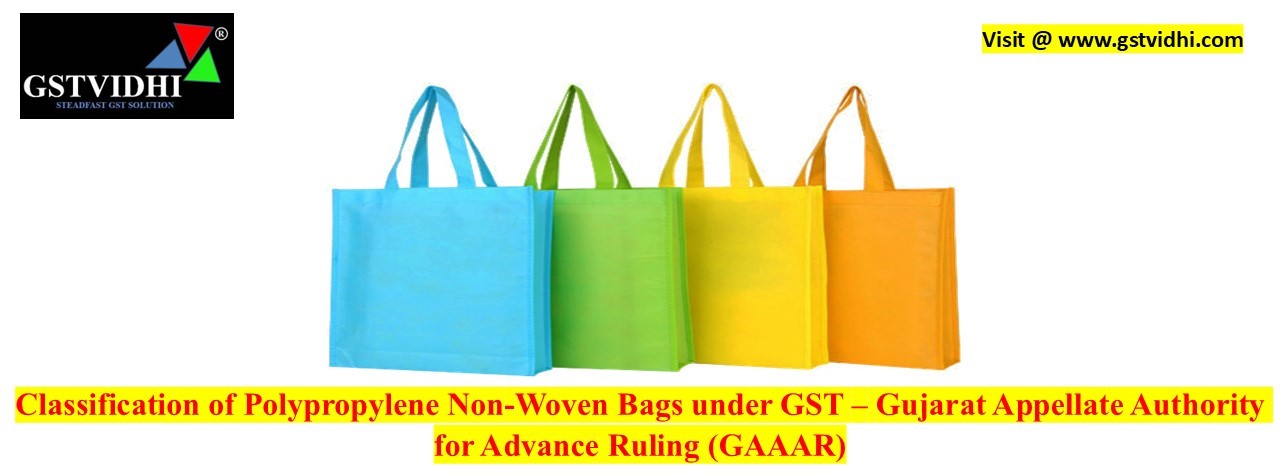
Classification of Polypropylene Non-Woven Bags under GST – Gujarat
Appellate Authority for Advance Ruling (GAAAR)
Name of
Party: M/s Karam Green Bags
Name of
Ruling Authority: Gujarat Appellate Authority for Advance
Ruling (GAAAR)
Ruling No.:
GUJ/GAAAR/APPEAL/2022/10
Date of
Ruling: 11.07.2022
Summary of
Ruling:
The Gujarat Appellate
Authority for Advance Ruling (GAAAR) upheld the ruling of the Gujarat Authority
for Advance Ruling (GAAR), classifying Polypropylene Non-Woven Bags under HSN
Code 3923 instead of 6305. As a result, these bags are liable to GST at 18% (9%
CGST + 9% SGST), and they are not eligible for exemption under Notification No.
01/2017-CT (Rate).
Facts of
Advance Ruling:
- The applicant, Karam Green Bags,
manufactures Non-Woven Bags using Non-Woven Fabrics, which in turn are
made from Polypropylene Granules through the Spun Bond Technology.
- The applicant contended that since Non-Woven
Fabric is classifiable under HSN 5603, Non-Woven Bags should be classified
under HSN 6305 (sacks and bags of textile materials).
- The applicant claimed that Non-Woven
Bags should be exempted under Notification No. 01/2017-CT (Rate).
Question
Raised:
1. Whether
Non-Woven Bags manufactured through Non-Woven Fabric (HSN 5603) should be
classified under HSN 6305 or HSN 3923?
2. Whether
these Non-Woven Bags are eligible for GST exemption under Notification No.
01/2017-CT (Rate)?
Submission
Made by Applicant:
- The applicant argued that Polypropylene
Non-Woven Fabrics are textiles, not plastics, and cited a clarification
from DKTE Center of Excellence in Non-Wovens supporting this view.
- Cited a West Bengal Appellate
Authority for Advance Ruling (WBAAAR) decision stating Polypropylene
Non-Woven Bags fall under HSN 6305.
- Referred to Madurai CGST
Commissioner’s clarification classifying these bags under HSN 6305.
- Contended that the GAAR ruling relied
on CBIC Circular No. 80/54/2018-GST, which pertains to laminated bags,
whereas their product is non-laminated and should be classified
separately.
- Relied on various judicial
precedents, including the Supreme Court’s judgment in Porritts and
Spencers (Asia) Ltd. v. State of Haryana, which held that textiles need
not be limited to cotton or silk.
Relevant
Sections & Notifications:
- Section 100 of the CGST Act, 2017 –
Governing appeals against Advance Rulings.
- HSN Code 6305 – Covers sacks and bags
of textile materials.
- HSN Code 3923 – Covers plastic
packaging materials, including sacks and bags.
- CBIC Circular No. 80/54/2018-GST –
Clarifies that Polypropylene Woven and Non-Woven Bags fall under HSN 3923
and attract 18% GST.
- Notification No. 01/2017-CT (Rate) –
Specifies GST exemptions.
Discussion
and Findings of Ruling Authority:
- The GAAR classified Polypropylene
Non-Woven Bags under HSN 3923 based on CBIC Circular No. 80/54/2018-GST,
stating that they are made from plastic (Polypropylene) and should be
classified as plastic products.
- The GAAAR upheld this classification,
stating that:
- The Textiles Committee Act, 1963
defines textiles based on cotton, wool, silk, and artificial silk. Polypropylene
is not included in this definition.
- The Madhya Pradesh High Court’s
ruling in Raj Packwell Ltd. established that HDPE (a plastic) bags are
classified as plastics, not textiles.
- The West Bengal AAR ruling in U.S.
Polytech was based on the assumption that Polypropylene Non-Woven Bags
fall under HSN 6305, without analyzing CBIC’s clarification on
Polypropylene being plastic.
- The CBIC Circular explicitly
classifies Polypropylene Non-Woven Bags under HSN 3923, which overrides
contrary Advance Rulings.
Final
Ruling and Conclusion:
- The appeal was rejected, and the classification
of Polypropylene Non-Woven Bags under HSN 3923 was upheld.
- These bags are liable to 18% GST (9%
CGST + 9% SGST).
- The claim for GST exemption under
Notification No. 01/2017-CT (Rate) was denied.
- Polypropylene Non-Woven Bags are not
considered textiles and should be classified as plastic packaging
materials
Disclaimer: All the Information is based on the notification, circular and order issued by the Govt. authority and judgement delivered by the court or the authority information is strictly for educational purposes and on the basis of our best understanding of laws & not binding on anyone.
Find the Attachment (Press on Click Here )
Click here